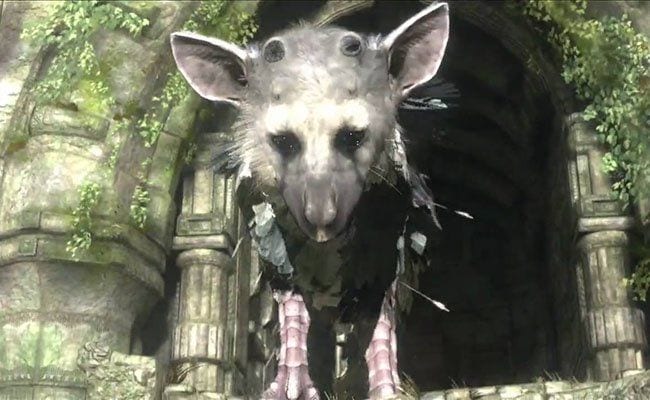
The Last Guardian is a fairy tale: A short story (well, relatively short for a game) featuring folkloric creatures and magic. It’s a simple definition, but it works. The Last Guardian fits perfectly within that simple categorization. It also works because Ico and Shadow of the Colossus, the two previous games by developer Team ICO, could also be described as fairy tales. But they’re not simple fairy tales. Each game, in its own way, questions the simple morality of the fairy tale.
The Last Guardian begins with you waking up next to a giant creature, a kind of cat-bird-dog called a “trico”. You’re covered in mysterious tattoos, and the trico is hurt and chained to an empty well. You’re both in dire straits, so naturally, you both help each other.
The game becomes a buddy adventure; you and trico against the strange castle that imprisons you both. The game encourages this simple view of the world by fashioning unique threats for the both of you. Trico is afraid of large stained-glass eyes planted strategically around the castle, and magical suits of armor will chase you, grab you, and try to carry you away. These early parts of the game set up a clear positive relationship between us and trico, and a clear antagonistic relationship between us and the castle. A simple morality befitting a fairy tale.
Then, about halfway through the game, we get a flashback that complicates this scenario. We see trico, now clad in armor, fly into a village at night and stick his head through an open window. It seems to be some kind of orphanage because there are several kids sleeping in a communal room. You, the main boy, are closest to the window, and trico scoops you up into his mouth just as a woman walks in and starts screaming. Outside, men with spears come running and attack trico.
Suddenly, our friend is now our enemy. Trico is abducting us, just like the suits of armor have been trying to do. As the villagers throw their spears, we’re conflicted: We don’t want to see our friend get hurt, but at the moment he certainly doesn’t seem to be our friend.
Trico manages to fly away, heading towards the castle, when he’s struck by lighting and falls into its depths. Near death but not dead, he’s rescued by, of all things, the magical suits of armor. They lift the cat-bird-dog onto a stretcher and carry him to the location where you begin the game. Eventually, the wounded trico vomits you back up, and so the flashback connects itself to the beginning of the game.
We take this new information with us when the story returns to the present. Trico is just as helpful and cute as ever, but now we view him with a new suspicion. The suits of armor are still just as dangerous as ever, still trying to steal us away, but now we view them with confusion. Our interactions haven’t changed, but we now know the situation is more complicated. This is not a story with a clear-cut good/bad guy since two of the three main forces in the story (trico and the suits) seem to have reversed their alliances.
In the end, we learn the truth: The castle is a grand mind control experiment forcing dozens of tricos to steal kids in return for food. The suits are a kind of security system, protecting the tricos while they’re controlled, then fighting against any who break free from the control.
Ultimately, we were correct from the very start. The conflict really does boil down to us against the castle, but the game takes time to investigate that conflict. It’s one thing to assume a simple morality, but it’s another thing to prove that simple morality. It’s one thing to assume goodness and badness, and another thing entirely to dig into why each side is good and bad.
The story is still a fairy tale, but that diversion into the past complicates the fairy tale morality and forces us to question our assumptions. Even if those assumptions are later proven correct, The Last Guardian shows us the value in questioning our assumptions.


![Call for Papers: All Things Reconsidered [MUSIC] May-August 2024](https://www.popmatters.com/wp-content/uploads/2024/04/all-things-reconsidered-call-music-may-2024-720x380.jpg)



